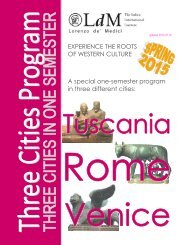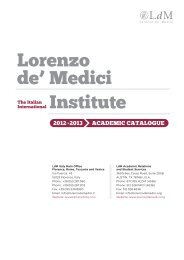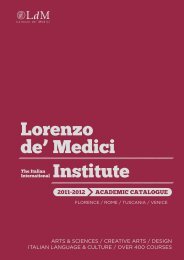aCademiC Catalog 2013-2014 - Lorenzo de Medici
aCademiC Catalog 2013-2014 - Lorenzo de Medici
aCademiC Catalog 2013-2014 - Lorenzo de Medici
Create successful ePaper yourself
Turn your PDF publications into a flip-book with our unique Google optimized e-Paper software.
School of Design FLORENCE<br />
Fashion Design Foundations<br />
FAS 162 F<br />
Cr: 3; Contact hrs: 90<br />
This studio-based course aims to introduce non fashion <strong>de</strong>sign<br />
stu<strong>de</strong>nts to the key principles of fashion <strong>de</strong>sign through modules<br />
about the four major foundation elements – illustration, sewing,<br />
draping and patternmaking. Un<strong>de</strong>rstanding of these key<br />
creative and technical principles that are the basis of the work<br />
of fashion <strong>de</strong>signers is also important for non <strong>de</strong>sign majors in<br />
fashion and related disciplines interested in <strong>de</strong>veloping a career<br />
in any aspect of the fashion industry. Application of these<br />
concepts to fashion related careers will be explored.<br />
Note: non-Fashion Design majors only<br />
Patternmaking I<br />
FAS 180 F<br />
Cr: 3; Contact hrs: 90<br />
Of the two methods of creating a garment, patternmaking<br />
is the more technical one. As such, it allows the <strong>de</strong>signer to<br />
manipulate already existing patterns efficiently and create new<br />
patterns with custom measurements. Stu<strong>de</strong>nts will start with<br />
basic patterns, including darts and princess line variations,<br />
and how to manipulate them respecting the fundamental<br />
rules of pattern making. There will be two basic projects<br />
during the semester: the skirt, with variations such as A-shape,<br />
gathered, with yoke, and the bodice, working with darts and<br />
princess line variations, and finally collars and sleeves. By<br />
un<strong>de</strong>rstanding pattern construction stu<strong>de</strong>nts will able to gain a<br />
wi<strong>de</strong>r un<strong>de</strong>rstanding of the possibilities and limits of a fashion<br />
<strong>de</strong>signer.<br />
Anthropology of Fashion and Desirability:<br />
Beyond the Catwalk<br />
FAS 185 F; Dual listed: ANT 185 F<br />
Cr: 3; Contact hrs: 45<br />
When we hear “fashion”, we think automatically of clothes and<br />
dress, but fashionability entails much more than the latest style<br />
of shoe on the catwalk. Trends of style and <strong>de</strong>sirability occur in<br />
every human society, from the most “simple” to our own highly<br />
complex international interactions. Using the fashion of dress as<br />
a starting point, this course examines the universal patterns and<br />
particular variations of fashionability in both Euro-American<br />
and non-Western societies. We will examine the phenomenon<br />
of fashion in clothing, speech, and activities by searching<br />
for trends and examining the trajectory of fashionability as<br />
practices move from the un<strong>de</strong>rground to the mainstream to<br />
being “old-fashioned”, because fashion is necessarily <strong>de</strong>fined<br />
in opposition to something that is not fashionable (is Mizrahi<br />
still cool now that he <strong>de</strong>signs for Target? Or is he even cooler?).<br />
We will investigate historic examples of past fashions, as well as<br />
current trends and the phenomenon of brand awareness, with<br />
an eye on our own sense of what makes something fashionable<br />
for us today.<br />
Textile Science<br />
FAS 195 F<br />
Cr: 3; Contact hrs: 45<br />
This core class teaches the fundamentals of textile and<br />
fabric science, bringing awareness of the variety of materials<br />
used in fashion and their applications. Stu<strong>de</strong>nts will receive<br />
a comprehensive overview of the textile industry. Special<br />
attention will be given to the dyeing, printing and finishing<br />
of textiles. Stu<strong>de</strong>nts will <strong>de</strong>velop a basic knowledge of textile<br />
terminology; of yarns, cloth construction, basic weaves; and of<br />
fibers and their origin, structure, properties and characteristics:<br />
thereby enabling them to make appropriate fabric selections.<br />
Fashion Design Computer Principles I<br />
FAS 200 F<br />
Cr: 3; Contact hrs: 60<br />
This course is <strong>de</strong>signed to familiarize stu<strong>de</strong>nts with the basic<br />
tools and techniques of Computer Ai<strong>de</strong>d Design standard in<br />
the fashion industry: Adobe Illustrator® and Adobe Photoshop®<br />
During the course of the semester, stu<strong>de</strong>nts create their own<br />
fashion project, from the conceptual phases to the presentation<br />
of the complete collection with all the necessary <strong>de</strong>tails,<br />
including the ren<strong>de</strong>ring of garment flats for both the technical<br />
and presentation formats, color-cards and different colorways.<br />
In addition to the prerequisites listed below the stu<strong>de</strong>nt is<br />
advised to have a general un<strong>de</strong>rstanding of garment structure.<br />
Prerequisites: FAS 160 Fashion Illustration I, or equivalent; or<br />
concurrent enrolment<br />
Introduction to Fashion Marketing<br />
FAS 215 F<br />
Cr: 3; Contact hrs: 45<br />
This course explores fashion marketing and merchandising.<br />
It focuses primarily on brands, and their fashion marketing<br />
strategies for product <strong>de</strong>velopment, advertising, promotion and<br />
retailing. The course analyzes the thinking behind the strategies<br />
for fashion products, paying special attention to the emotional<br />
aspects of fashion communication. Stu<strong>de</strong>nts will approach<br />
current business practices and examine new and emerging<br />
trends and issues that impact on the fast-moving environment<br />
of the fashion and textile industry, looking at the globalization<br />
of the industry, tra<strong>de</strong> shows and key events. Specialized topics<br />
inclu<strong>de</strong> the importance of the European fashion system, with<br />
a comparison to some American brands and strategies. Case<br />
studies will provi<strong>de</strong> a vision of how companies in today’s<br />
environment are evolving marketing strategies to meet the new<br />
consumer’s <strong>de</strong>mand, in terms of product <strong>de</strong>sign, distribution<br />
and communication.<br />
Fabric Styling<br />
FAS 220 F<br />
Cr: 3; Contact hrs: 60<br />
In this course on surface <strong>de</strong>sign stu<strong>de</strong>nts learn many different<br />
textile techniques such as swatch weaving, dyeing yarns,<br />
direct painting and wet painting, tie dye or shibory, discharge<br />
print, block printing, silk screening, free motion stitching,<br />
embroi<strong>de</strong>ry, cords and yarns appliqué, beading, smocking, etc.<br />
To emphasize the communication aspect, the stu<strong>de</strong>nts create a<br />
number of mood boards with different themes, learning how to<br />
sketch quick shapes and “dress” them up. The projects carried<br />
out by stu<strong>de</strong>nts consist of samples with different techniques,<br />
mood boards, and the creation of a personal trend book that<br />
illustrates in a professional way the techniques learned during<br />
the course.<br />
Fabric Styling (Summer only)<br />
FAS 221 F<br />
Cr: 3; Contact hrs: 45<br />
In this course on surface <strong>de</strong>sign stu<strong>de</strong>nts learn many different<br />
textile techniques such as swatch weaving, dyeing yarns,<br />
direct painting and wet painting, tie dye or shibory, discharge<br />
print, block printing, silk screening, free motion stitching,<br />
embroi<strong>de</strong>ry, cords and yarns appliqué, beading, smocking, etc.<br />
To emphasize the communication aspect, the stu<strong>de</strong>nts create a<br />
number of mood boards with different themes, learning how to<br />
sketch quick shapes and “dress” them up. The projects carried<br />
out by stu<strong>de</strong>nts consist of samples with different techniques,<br />
mood boards, and the creation of a personal trend book that<br />
illustrates in a professional way the techniques learned during<br />
the course.<br />
Fashion Consumer Behavior<br />
FAS 225 F<br />
Cr: 3; Contact hrs: 45<br />
Un<strong>de</strong>rstanding the consumer is at the center of this course.<br />
Through fashion concepts and theories, cultural influences,<br />
<strong>de</strong>mographics, psychographics and consumer dynamics<br />
will we try to <strong>de</strong>mystify the <strong>de</strong>cision-making process of the<br />
omnipotent customer; analyzing perceptions, communication,<br />
and ethics to <strong>de</strong>termine how a customer can turn into a<br />
consumer. Although aimed at the fashion stu<strong>de</strong>nt this course is<br />
applicable to any sector of consumption.<br />
Visual Merchandising<br />
FAS 235 F<br />
Cr: 3; Contact hrs: 45<br />
This course explores contemporary visual merchandising<br />
strategies. It focuses primarily on un<strong>de</strong>rstanding visual<br />
merchandising techniques, concepts and processes, and<br />
recognizes how visual merchandising efforts support retailing<br />
106<br />
LdM Aca<strong>de</strong>mic <strong>Catalog</strong> <strong>2013</strong>-<strong>2014</strong>





